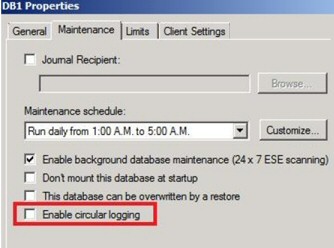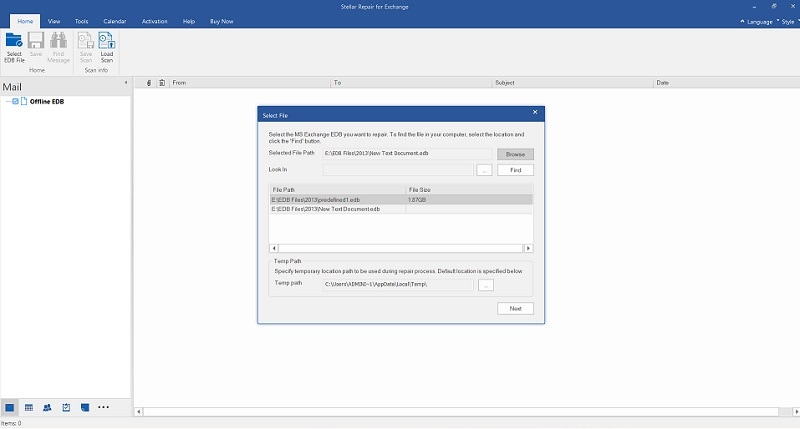

Specified database: Error code: An Active Manager operation. Failed Error: Couldn't mount the database that you specified. You cannot create a new Exchange Server 2010 Mailbox database in a. I also found this article and tried Set-ADServerSettings –PreferredServer, but it doesn’t make any different. The last failure was: MapiExceptionMdbOffline: Unable to Get Catalog State (hr=0x80004005, ec=1142) While starting database RDB2, the following error occurred: Database is in inconsistent state.Įxchange Search Indexer failed to enable the Mailbox Database RDB2 (GUID = df7b508e-10bf-4e8d-83ab-d271788d33d2) after 1 tries. Error: There is only one copy of this mailbox database (RDB2). Service recovery was attempted by failover to another copy, which was unsuccessful in restoring the service. To help identify the specific failure, consult the Event log on the server for other storage and "ExchangeStoreDb" events. (hr=0x80004005, ec=-550)Īt ' 9:22:13 PM' the Exchange store database 'RDB2' copy on this server detected corruption on the active copy of the database.

Error: Operation failed with message: MapiExceptionCallFailed: Unable to mount database. Error: An Active Manager operation failed. The mount operation will be tried again automatically.Īctive Manager failed to mount database RDB2 on server. For more information, consult the Event log on the server for "ExchangeStoreDb" or "MSExchangeRepl" events. Operation terminated with error -1003 (JET_errInvalidParameter, Invalid API parameter) after 0.31 seconds.Īt ' 9:22:13 PM', the copy of database 'RDB2' on this server encountered an error during the mount operation. Usage Error: Missing logfile base name specification. Įxtensible Storage Engine Utilities for Microsoft(R) Exchange ServerĬopyright (C) Microsoft Corporation. Detailed error(s):Īn Active Manager operation failed. Error: The database 'RDB2' was not mounted because errors occurred either while validating database copies for possible activation, or while attempting to activate another copy. Error: An error occurred while trying to select a database copy for possible activation. Specified database: RDB2 Error code: An Active Manager operation failed. I get this message:Ĭouldn't mount the database that you specified. en-us/library/dd876874.aspxĪfter restoring the database to a folder called rdb2, I try to mount the recover database in EMC. A recovery database is an Exchange 2010 feature that replaces the recovery storage group (RSG) found in previous versions of Exchange. Understanding Backup, Restore and Disaster Recovery: Exchange 2010. Similarly, you can use Get-MailboxDatabaseCopyStatus cmdlet to validate that the database copy status is normal.I am following this article to recover email in Exchange 201. We must correct such issues before all the Databases can pass this test. In this scenario, DB01 on MBG-MBX02 is in a suspended state. If the command finds any issues with respect to the database copy process, then an appropriate error will be displayed against the specific mailbox server. The above command will fetch all the Exchange servers with Mailbox role and pipe the server name to the “Test-ReplicationHealth” command which will then fetches the replication status of all the mailbox databases which are the part of a DAG and shows the status of each. Get-MailboxServer | Test-ReplicationHealth You can use these two cmdlets in conjunction with the get-databaseavailabilitygroups to obtain desired results. Microsoft provides two cmdlets to monitor the replication status of the mailbox databases in the DAG. Get-MailboxDatabaseCopyStatus and Test-ReplicationHealth. When you are monitoring the high availability of the Exchange servers it is important to have a closer look on the replication health of each database copies that are hosted on different mailbox servers. View Mailbox Database Replication Progress in Exchange 2010 DAG
Mount database exchange 2010 how to#
In this post we will see how to View Mailbox Database Replication Progress in Exchange 2010 DAG. You can also call Database replication as adding database copies. Database replication is basically replicating the Mailbox Database from one member in the DAG to another member. Any server in the DAG can host a copy of a mailbox database from any other server in the DAG. The database switch-over time is less than 30 seconds which will significantly improve the overall up-time. You will need just two Mailbox Server to start with the high-availability features of Exchange 2010. Adding Multiple mailbox servers to the DAG and replicating all mailbox databases with other member servers provides automatic failover recovery at the database level.

Database Availability Groups(DAGs) in Exchange 2010 is data redundancy, high availability and disaster recovery feature.


 0 kommentar(er)
0 kommentar(er)
